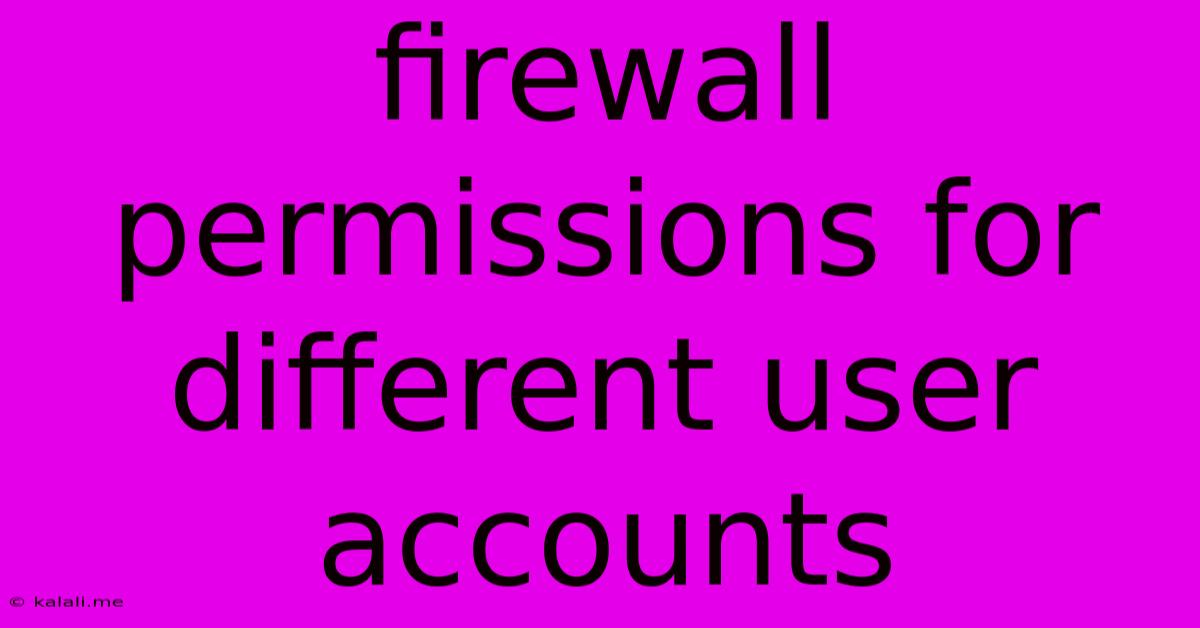Firewall Permissions For Different User Accounts
Kalali
May 23, 2025 · 4 min read

Table of Contents
Firewall Permissions for Different User Accounts: A Comprehensive Guide
Meta Description: Learn how to configure firewall permissions for different user accounts on your system, enhancing security and controlling network access for each user. This guide covers Windows, macOS, and Linux, explaining the importance of granular control and best practices for secure user management.
Managing firewall permissions on your system is crucial for maintaining security. A well-configured firewall acts as a gatekeeper, controlling incoming and outgoing network traffic. However, simply having a firewall isn't enough; you need to tailor its permissions to each user account, creating a layered defense against unauthorized access and malicious activity. This guide will walk you through the process of setting up granular firewall permissions for different user accounts on Windows, macOS, and Linux systems.
Why Granular Firewall Control Matters
Implementing different firewall rules for different users significantly enhances security by:
-
Limiting exposure to threats: Each user account has different needs and privileges. Restricting access based on user roles minimizes the impact of a compromised account. If a less privileged user's account is compromised, the attacker has limited network access compared to an administrator account.
-
Enhancing data privacy: By restricting network access for specific users, you prevent unauthorized data transfers or access to sensitive information. This is particularly important in environments with multiple users sharing the same system.
-
Improving system stability: Improperly configured firewall rules can lead to system instability or unexpected network behavior. Granular control helps maintain a stable and secure network environment.
-
Compliance with security policies: Many organizations have strict security policies requiring different levels of network access based on employee roles. Granular firewall control allows for easy implementation of these policies.
Configuring Firewall Permissions: A Platform-Specific Overview
The methods for configuring firewall permissions vary across operating systems. Let's explore the basics for Windows, macOS, and Linux.
Windows Firewall
Windows Firewall allows for user-specific rule creation, although not directly at the account level. The key is to create rules based on the applications used by different users or groups. For instance, you could create a rule allowing only specific programs to access the network for standard users, while administrator accounts have broader permissions. You can manage these rules through the Windows Firewall with Advanced Security application. This involves creating inbound and outbound rules based on programs, ports, and user groups.
macOS Firewall
macOS offers a more streamlined firewall management experience. While not allowing direct user-level permission specification, you can control which applications are allowed access to the network. This works similarly to the Windows approach, effectively controlling access based on the applications used by different users. Access is managed through the System Preferences > Security & Privacy > Firewall. Adding applications to the list allows or blocks network communication for those specific applications.
Linux Firewall (iptables/firewalld)
Linux distributions utilize different firewall tools, commonly iptables or firewalld. These tools offer advanced capabilities for granular control, often allowing user-based rules or rules based on user groups. The complexity increases significantly. The configuration generally involves using command-line interfaces to create custom rules based on users, groups, ports, and protocols. Consult your distribution's documentation for detailed instructions. For example, firewalld often allows managing zones and associating users or groups with specific zones that have predefined firewall rules.
Best Practices for Managing Firewall Permissions
Regardless of the operating system, adhering to best practices is essential for effective firewall management:
-
Principle of least privilege: Grant only the necessary permissions to each user account. Avoid granting excessive privileges.
-
Regular review: Periodically review and update firewall rules to ensure they align with the current security needs and user roles.
-
Documentation: Maintain detailed documentation of all firewall rules and their purpose.
-
Testing: Thoroughly test any firewall changes in a controlled environment before deploying them to a production system.
-
Use strong passwords: A robust password policy significantly reduces the risk of unauthorized access.
-
Regular updates: Ensure your operating system and firewall software are up-to-date with the latest security patches.
By implementing these strategies and utilizing the platform-specific configuration methods, you can create a more secure and robust network environment, tailored to the specific needs of each user on your system. Remember, security is an ongoing process, requiring consistent monitoring and adaptation to emerging threats.
Latest Posts
Latest Posts
-
How Much Is 25 20 Dollar Bills
Jul 05, 2025
-
How Many Apples In 3 Lb Bag
Jul 05, 2025
-
What Is Half A Quarter Of 400
Jul 05, 2025
-
How Do You Make A Vegetable Necklace
Jul 05, 2025
-
How Many 750ml Are In 1 75 Liters
Jul 05, 2025
Related Post
Thank you for visiting our website which covers about Firewall Permissions For Different User Accounts . We hope the information provided has been useful to you. Feel free to contact us if you have any questions or need further assistance. See you next time and don't miss to bookmark.